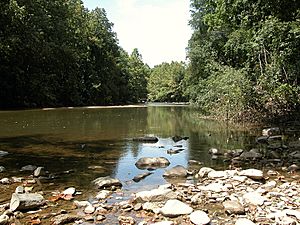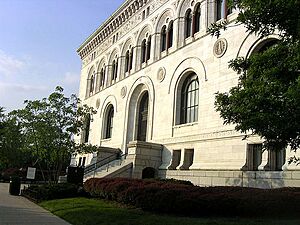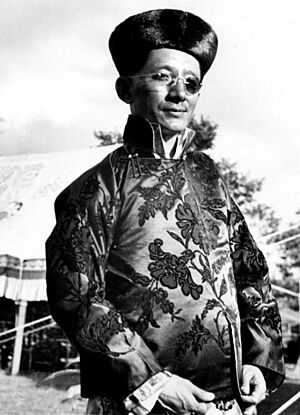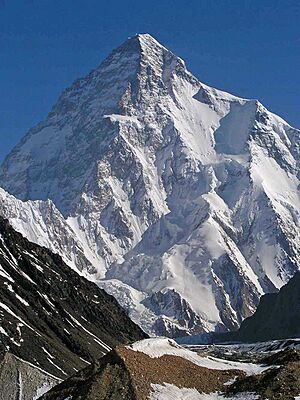Elaine Hamilton-O'Neal facts for kids
Quick facts for kids
Elaine Hamilton
|
|
|---|---|
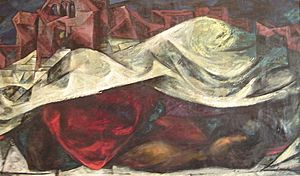
Elaine Hamilton, oil on canvas, 48"x28".
Date unknown (probably between 1948 and 1952). Title unknown (if any). |
|
| Born |
Elaine Hamilton
October 13, 1920 Paradise, near Catonsville, Maryland
|
| Died | March 15, 2010 (aged 89) |
| Nationality | American |
| Education | Maryland Institute College of Art; Robert Brackman, Art Students League of New York; Diego Rivera, National Polytechnic Institute in Mexico City; Accademia di Belle Arti in Florence, Italy |
| Known for | painting |
|
Notable work
|
Burst Beyond the Image 1960; Sans titre, 1960; Silent Space 1969 |
| Movement | realism, abstract expression, mural, action, lyrical abstraction |
| Patron(s) | Michel Tapié de Céleyran |
Elaine Hamilton-O'Neal (October 13, 1920 – March 15, 2010), known professionally as Elaine Hamilton, was a famous American abstract painter and muralist. She was born near Catonsville, Maryland. A well-known French art critic, Michel Tapié de Céleyran, admired her work. She showed her art all over the world, including in the United States, Mexico, Asia, Japan, and Europe. She even exhibited twice at the important Venice Biennale art show. In 1968, she won first prize at the Biennale de Menton in France. She is especially known for her later style, called action painting.
Elaine Hamilton was also an experienced mountain climber. For over 30 years, she climbed in the Himalayas. She even climbed K2, which is part of the Karakoram mountain range. K2 is known as the Savage Mountain because it is very hard to climb. For every four people who reach the top, one has died trying. Over the years, Hamilton made nine trips to different mountains in the Himalayas. She also visited the former kingdom of Sikkim as a guest of its king, Tashi Namgyal, and his family.
For three decades, Hamilton traveled across India, Pakistan, Sikkim, and Japan. In Pakistan in 1959, she was asked to create art for an exhibition. The government of Pakistan also gave her permission for her first K2 expedition. This trip helped her find her unique artistic style. It led to her first completely abstract painting, called Burst Beyond the Image.
Contents
Early Life and Adventures
Elaine Hamilton was born on October 13, 1920, into a middle-class family. They lived in a place called Paradise, near Catonsville, Maryland. Her parents were Robert Bruce and Lee Hamilton. Elaine grew up at Emerald Hill, her family's home in Daniels, along the Patapsco River. This was just north of Ellicott City.
Hamilton spent part of her childhood near Orange Grove, inside the Patapsco Valley State Park. Orange Grove was a mill town with a flour mill. It's known as one of the most beautiful parts of Patapsco. In the 1920s, the Hamilton family would camp there for four or five months each summer. It was a popular vacation spot for wealthy families. The park encouraged middle-class families to camp there for a long time. They called it "roughing it pleasantly" for their minds and bodies.
Her time at the park was a mix of tough outdoor living and modern comforts. The family slept on straw beds under a canvas tent. They walked to a local spring several times a day for fresh water. But they also cooked on a modern oil stove and had electricity from Bloede's Dam. They even brought their piano to the campsite to play music in their "living room" tent! Once a week, they walked over a mile to Orange Grove to buy groceries. By living in the wilderness, Hamilton said she gained confidence and a sense of adventure. She "learned to be creative and inventive."
At the park, Hamilton learned to paint and swim. She also developed excellent hearing and a "strong sense of smell." She learned to recognize animal and bird sounds. She also learned how to avoid copperhead snakes. With few other children around, Hamilton grew closer to her older brothers, Robert Jr. and Doug.
Her summers at the park were very important for her future. They helped her become a Fulbright Scholar and a successful artist. Hamilton's experience at Patapsco showed how she combined a rugged outdoor life with intellectual and cultural interests.
In her later years, Hamilton often said that the platform tent where her family lived each summer was the place that defined her most.
Marriage and Life Abroad
In 1942, Elaine Hamilton met William O'Neal. They got married soon after meeting at a fancy dinner. William O'Neal was often away for his work in the aerospace industry. He supported Elaine's adventures from afar.
During their marriage, the O'Neals mostly lived apart. They did not have children. Hamilton said they discussed this before marrying. "We wanted to be 100 percent of whatever we were," she explained.
In 1952, Hamilton and her husband bought the Old Shades Creek Mill in Mountain Brook, Alabama. But Elaine's art shows kept her traveling. She described her relationship with O'Neal in an interview. While she was on world tours, O'Neal "was working to put the first man on the moon." He worked for the Glenn L. Martin Company (now Lockheed Martin) and later in Birmingham.
In the early 1960s, Hamilton moved to Paris. In 1971, she bought a chateau (a large French country house) in France. She lived and worked there for the next 30 years. Meanwhile, O'Neal kept their home at the Old Mill in Mountain Brook. The Old Mill was built in 1926 and is a symbol of Mountain Brook.
Even with the distance, Hamilton said they were close. She lived in her chateau, but would stop everything when her husband and his friends came for a French holiday. She would cook and entertain them. Then, she would fly to Birmingham to visit him. She enjoyed hosting scientists in aerospace engineering there.
Learning and Inspiration
In 1945, Hamilton graduated from the Maryland Institute (now MICA). She then studied for two years with Robert Brackman in New York. She was a member of the Art Students League.
In 1949, Hamilton continued her studies in Mexico City at the National Polytechnic Institute. She learned from the famous muralist Diego Rivera. While there, she was asked to paint a 47-foot mural for the Instituto Allende in San Miguel de Allende.
Hamilton didn't compare herself to other artists of her time. She wasn't interested in Picasso. While she admired José Clemente Orozco and Diego Rivera, she mainly wanted to learn how to paint large outdoor murals.
By 1949, when Hamilton went to Mexico, she had been married for seven years. In 1951, she returned to Baltimore for her own art show at the Baltimore Museum of Art. In 1952, she traveled to Italy on a Fulbright Scholarship. This allowed her to study painting at the Accademia di Belle Arti in Florence. Her scholarship was extended in 1953, and she stayed in Italy for seven more years. After showing her art in Rome, Milan, and at the Venice Bienniale, she felt drawn to the Himalayas.
The Himalayas: Mountains and Meaning
The Himalayas are a huge mountain range in Asia. They separate the Indian subcontinent from the Tibetan Plateau. This mountain system also includes the Karakoram and the Hindu Kush. Together, they have the world's highest peaks, like Mount Everest and K2. K2 is part of the Karakoram Range.
These mountains have greatly influenced the cultures of South Asia. Many Himalayan peaks are considered sacred in Hinduism, Buddhism, and Sikhism. K2 is called the Savage Mountain because it is so dangerous to climb. It has the second-highest death rate for climbers. Unlike Annapurna, which has the highest death rate, K2 has never been climbed in winter.
Hamilton explained why she was drawn to the high mountains in Pakistan. "I wanted to see where the earth and the sky touched," she said. Over the years, she made nine trips to different Himalayan mountains. She also visited the former kingdom of Sikkim as a guest of Tashi Namgyal, the king of Sikkim, and his royal family.
King Namgyal was the 11th ruler of Sikkim. He was born in Tibet and crowned by the 13th Dalai Lama. He wanted Sikkim to have closer ties with India. When he died in 1963, his son Palden Thondup Namgyal became king. Hamilton stayed close with him. Legend says that the Buddhist saint Guru Rinpoche visited Sikkim in the 9th century. He brought Buddhism and predicted the time of the monarchy. It was in Sikkim that Hamilton learned about Buddhism. She loved the country and its people, returning every year for 30 years.
About her trips to K2 and Everest, she wrote: "I often return to the 'Abode of the Snows' because there my thoughts become clear. They turn into shapes that find their way into the movements and rhythms of my paintings."
During these years, Hamilton was influenced by early Sienese and later Renaissance painting. Especially Giotto's use of space inspired her to move towards abstract art. Hamilton lived in Florence and showed her paintings in Rome, Venice, Milan, and Florence. She would visit Maryland almost every year for shows, but she spent most of her career living abroad.
An Artist's Journey
Elaine Hamilton's art changed a lot over time. Her work went from realistic portraits in the 1940s to completely abstract art in the 1960s and beyond. She won a prize for portrait painting at the Maryland Institute College of Art in 1945. So, it made sense that she studied with Robert Brackman in New York, who was a master of realistic portraits and other figurative (showing real-life figures) painting.
In the late 1940s and early 1950s, you can see the influence of Diego Rivera in her art. Her paintings had earthy textures and colors. They also had heavy, sculpted, almost cubist (using geometric shapes) forms as they became more abstract (see right). Her paintings also grew larger, which was also a result of studying with Rivera.
Some of her early 1950s paintings show intense, powerful images. One painting from Mexico, which she said was of her maid's dead child, shows a shadowy face surrounded by leaves and swirls in deep red colors.
During the 1950s and 1960s, Hamilton showed her paintings across Italy. This included the Venice Biennale, Rome, Milan, and the Uffizi Gallery in Florence. She also exhibited at the Pakistan Arts Council in Karachi. In 1956 and 1958, Hamilton was invited to exhibit at the Venice Biennale. Even with her travels, she remained important in the Baltimore contemporary art scene. She won the Popular Prize at the Baltimore Museum of Art's Maryland Artists Exhibition in 1952 and again in 1959.
Hamilton had solo shows in major galleries and museums worldwide. Her work was shown in Rome, Milan, Turin, Italy, Florence, Italy, Mexico City, Osaka, Tokyo, and Karachi, Pakistan. She also participated in many group exhibitions in these cities, as well as in Paris, the Whitney Museum in New York City, and the Corcoran Gallery in Washington, DC.
Around 1960, she started her own style of action painting. She is probably best known for these later, abstract expressionist paintings. Sometimes she is called a lyrical abstractionist. In 1968, she won first prize at the Biennale de Menton in France.
As Hamilton became more famous, art students looked to her for ideas. Her influence spread across Europe and around the world. One young Pakistani artist, Ismail Gulgee, was especially influenced by her. Partha Mitter wrote in her book, Indian Art: "Impressed by the visiting American painter Elaine Hamilton, Gulgee enthusiastically plunged into action painting..." Jane Turner also wrote about Hamilton's influence on Gulgee in The Dictionary of Art.
According to David L. Craven, a professor of Art History, Hamilton became like an ambassador in South Asia. He said, "Abstract expressionism was promoted as a universal style in Pakistan during the 1950s by a U.S. artist named Elaine Hamilton."
While Hamilton lived in France, she gained the support of Michel Tapié de Céleyran. He was a very important French critic and painter. Tapié was an early supporter of European Abstraction Lyrique, also known as tachisme. This style is similar to abstract expressionism in Europe. He was related to the famous painter Henri de Toulouse-Lautrec.
Tapié was very supportive of young artists. He organized many exhibitions of new and modern art worldwide. In 1952, Tapié was the curator for Jackson Pollock's solo show in Paris.
In 1960, Hamilton created her first purely abstract oil painting, called Burst Beyond the Image. She made it after an expedition to K2 in Pakistan. This painting was her first step into the abstract world of action painting. This style shows the energetic movements of the artist painting. Today, this painting is still in Hamilton's own collection.
In late 1960, after her Himalayan adventure, she returned to France. She quickly created many more large "action" paintings for shows in Japan. Around this time, Hamilton caught the attention of Michel Tapié. He showed her paintings at the Fujikawa Gallery in Osaka, Japan. This show took place from April 12–18, 1961. It was done with the Gutai Group, a group of avant-garde (new and experimental) artists from Japan after the war. Tapié also curated a second show at the International Center of Aesthetic Research in Turin, Italy.
The 2006 Benezit Dictionary of Artists praised Hamilton. It said, "A globetrotter who has scaled the heights of the Himalayas, Hamilton makes profoundly serious work. Clearly part of the movement known as 'lyrical gestural abstraction', her painting is full of verve and invention and manifests an extraordinary gift for colour and substance."
In 2009, a writer named Martha Thomas visited Hamilton's home. She saw many of Hamilton's works in her private collection. Instead of hanging on walls, her earlier paintings were stacked safely against them.
Most of the paintings in Hamilton's lower gallery were her later works. They were bright, energetic splashes of color with swirls, drips, and slashes of paint. Some canvases were six feet long and four or five feet high. A few were even round. Hamilton said she wanted to challenge herself and "get out of the square thing." In some, color exploded from the center like a supernova against a dark background. In others, the canvas was completely covered in a fury of colorful strokes.
Her work has been called abstract expressionism and "action painting." But Hamilton said the Buddhist monks she knew in Tibet described it best: "It's meditation in action," she said. "That's not a contradiction. When you meditate, it doesn't mean empty. It's making space for things to come in."
Hamilton continued to develop her abstract painting style for the rest of her life. Today, her work is shown at the Birmingham Museum of Art in Alabama. Her oil on canvas painting called Silent Space, from about 1969, is owned by Sarfaraz Aziz in London. Other pieces are in public and private collections in Austria, France, Germany, India, Italy, Mexico, Pakistan, Switzerland, and the United States.
Later Years and Legacy
In November 2009, Martha Thomas from Baltimore Magazine wrote an article about Hamilton. Hamilton shared her life stories and gave a tour of her home. It was filled with her art, artifacts, and souvenirs from her amazing life.
Throughout her life, Hamilton called many places "home." At one point in France, she owned a 42-room chateau filled with art and antiques. She later moved to a smaller, charming French chateau with 18 rooms.
Hamilton lived in apartments in Florence and New York. She even lived in a tent at the Mount Everest base camp. When she was in Mexico City, the Rotary Club of Houston, Texas hosted her. After returning to America, Hamilton and her husband lived together in an old, converted grist mill in Mountain Brook, Alabama.
In 2002, the couple decided to sell the Old Mill and move to Maryland. They planned to live together after so many years apart. On the day after their 60th wedding anniversary, as they prepared to move, Bill went to the doctor. He was transferred to the hospital and died of heart failure that day.
Hamilton still moved to Maryland, as planned, to be near her family. She described her brothers as wonderful friends. She also had strong bonds with her nieces and nephews. "I had always told them that if they ever wanted to run away, they could run to me," she said. "I was far away, and safe." She also had space for guests. "Sometimes too much space," she laughed.
In 2009, Hamilton had just one guest room. It was decorated in shades of green. It had twin beds with silk spreads she made in France and olive green Tibetan rugs. The walls held relief rubbings from tombs in Pakistan. Her travels were in the past, but evidence of her remarkable life was everywhere.
At the end of her life, Hamilton was happy living in Granite, near where she grew up. Her eight-room home felt like a piece of France, brought to the Emerald Hill countryside. It had a brick front, Palladian windows, and a gravel driveway. It was large with high, stepped ceilings that she designed herself. It was in the "Chartreuse" style, common in southern France.
A tour of her home showed a lifetime of adventure. "It's filled with souvenirs," she said. "It's a vagabond's house." She laughed heartily, her eyes sparkling behind thick glasses.
Her Louis XV sofas were from the 1800s. They had hand-embroidered pillows from Pakistan. Her Regency fireplace mantel, made of heavy marble, displayed a bronze cat by sculptor Antoine-Louis Barye. It also had antique toys from India and a pair of cloisonné vases (brought from Tibet on the back of a yak). Her dining room furniture was from the Renaissance. The table had sturdy brass candlesticks from the same period, which she bought for $200 as an art student in Florence. "They are the real thing," she noted. "A lot of people have sat in front of those."
Everywhere, there were rugs. Many were brightly colored with traditional Tibetan designs. They had thick, knotted-wool patterns of dragons, tigers, and flowers. Besides rugs, skins from leopards and tigers (with heads still on) were draped over seats and low tables in Hamilton's meditation room. This room was a special sanctuary off the library. It had a gilded, wood altar from floor to ceiling, with spaces holding different statues of the Buddha. The walls were painted in traditional colors: deep earth red at the bottom, then horizontal bands of orange and gold representing different stages of clarity, and finally a blue ceiling, meaning nirvana. "I've had this exact room in every house I've owned for the last 40 years," Hamilton said. "Everything in Buddhism is symbolic and has definite meaning." She warned: "Don't use the word décor."
Whether or not they were "décor," photographs were a key part of Hamilton's belongings. If the furniture, paintings, and special objects weren't enough proof of her adventures, there were plenty of photos to complete the story. There was a picture of her mother, a beautiful woman from the 1920s. There was a photo of Hamilton climbing an icy ledge in Pakistan's Karakoram range. And a picture of a Tibetan friend who became a nurse in Pennsylvania, partly thanks to Hamilton's help.
Hamilton quickly told each story, knowing she had so many more to share. Perhaps sensing a visitor's disbelief, she would point to the library or her bedroom. "Oh, I have photos of all that," she'd say, promising proof that her amazing tales were true.
In the gallery, which she built with high ceilings and special lighting for her large paintings, Hamilton looked through scrapbooks. She found a page from the May 13, 1951, edition of The Baltimore Sun Magazine. Its edges were yellow and brittle. Hamilton was on the cover, swirling a large cape, with the headline, "Baltimore's Lady Bullfighter." She explained: "I saw the bullfights [in Mexico] and was traumatized. They gave me migraines." Her solution? "I had to find out what it was all about," so she trained to enter the ring.
She explained that bullfighters first swing the cape in wide circles. "Then begin to bring the bull closer and closer," shortening the red cloth. She described the fight as a mythical challenge between strength and intelligence that "equalizes life and death." Hamilton noted that she did not actually kill the bull. But she did come out sore and covered with bruises. "You don't even realize you're getting grazed at the time," she said, "but you come out all black and blue."
Returning to her scrapbook, she pointed out a program from a 1951 solo show at the Baltimore Museum of Art. She also showed a magazine photo of her on scaffolding in Mexico City. She was working on a 47-foot mural she painted at the art institute in San Miguel de Allende, after helping the muralist Diego Rivera.
On Monday, March 15, 2010, Elaine Hamilton O'Neal passed away in Woodstock, Maryland. The cause was not known. She stopped painting around 2004 due to eye problems, but otherwise, she was in good health. In her later years, she was involved in her community. She was a member of the Great Patapsco Community Association and the local art museum. She regularly supported Baltimore's Walters Art Museum. Her brother Douglas was Vice-President of its Board of Trustees from 2009–2010. The Walters Art Museum is one of the best small, private art collections open to the public in the United States.
Solo Exhibitions
|
|
Group Exhibitions
|
Awards and Honors
|


